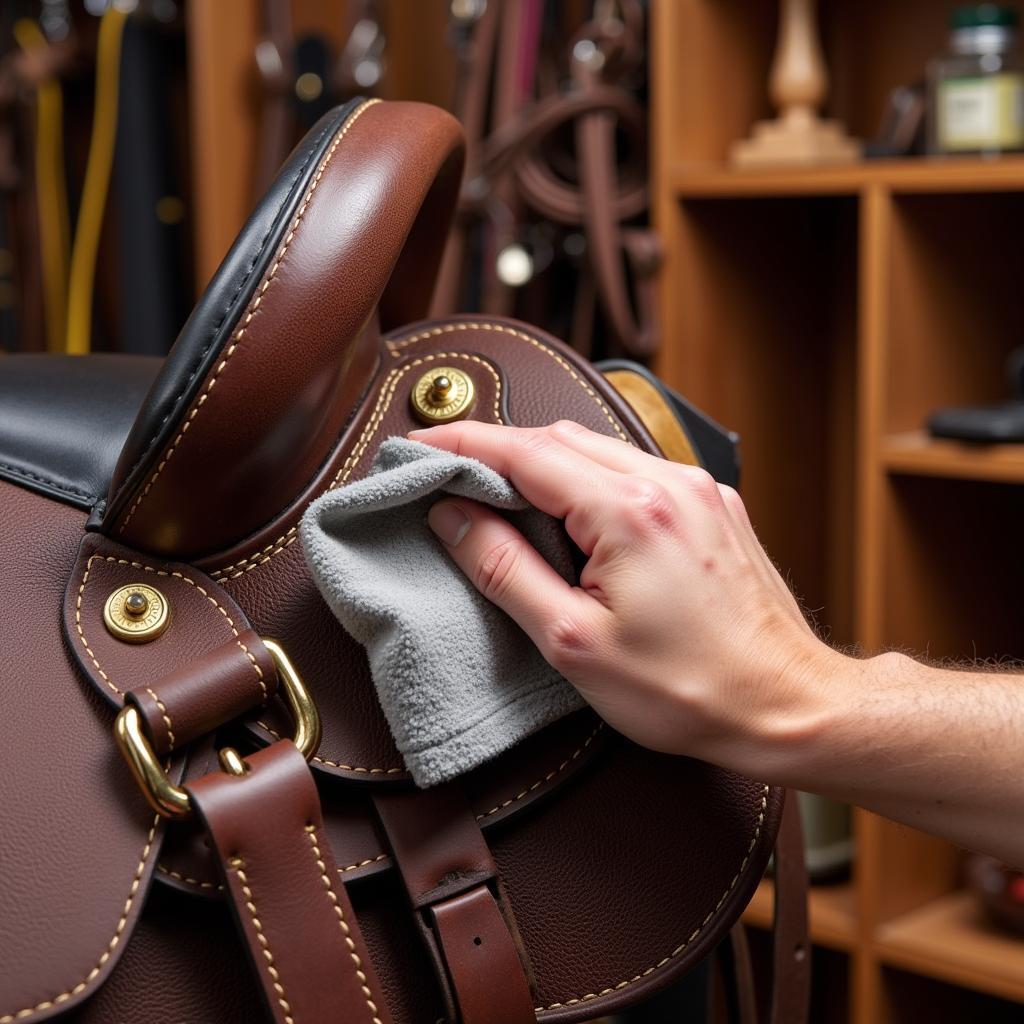A Cinch Horse Saddle is a crucial piece of equipment for any rider. It’s the connection between you and your horse, ensuring a secure and comfortable ride. Choosing the right cinch can significantly impact your horse’s performance and well-being. This comprehensive guide will delve into everything you need to know about cinch horse saddles, from different types and materials to proper fitting and maintenance.
Understanding the Cinch Horse Saddle
The cinch, often mistakenly referred to as a girth, is the wide strap that fastens the saddle securely to the horse. It lies beneath the horse’s belly, just behind the elbows. A properly fitted cinch is essential for both the horse’s comfort and the rider’s safety. It distributes the rider’s weight evenly, preventing pressure points and sores. A loose cinch can cause the saddle to slip, leading to dangerous situations, while a too-tight cinch can restrict the horse’s breathing and movement.
Choosing the right cinch depends on several factors, including the horse’s conformation, riding discipline, and personal preference. Some horses are more sensitive than others, requiring specific materials or designs. Understanding the various types of cinches available is crucial for making an informed decision.
You can find a wide selection of horse saddle hardware to complement your cinch.
Types of Cinch Horse Saddles
There are several types of cinches available, each with its own advantages and disadvantages.
- String Cinch: Made from mohair or other natural fibers, string cinches are known for their breathability and flexibility. They conform well to the horse’s shape and are often preferred for horses with sensitive skin.
- Neoprene Cinch: Neoprene cinches are durable, easy to clean, and offer good shock absorption. They are a popular choice for various riding disciplines.
- Leather Cinch: Traditional and aesthetically pleasing, leather cinches provide a classic look. They require regular cleaning and conditioning to maintain their suppleness.
- Felt Cinch: Felt cinches offer excellent padding and are often used with horses prone to girth galls.
Choosing the right type depends largely on the individual horse and riding style. Experimenting with different materials and designs might be necessary to find the perfect fit.
Fitting a Cinch Horse Saddle Correctly
Properly fitting a cinch is crucial for the horse’s comfort and well-being. A poorly fitted cinch can lead to discomfort, sores, and even behavioral problems.
- Start Loose: When first saddling, fasten the cinch loosely, allowing the horse to relax and exhale.
- Gradual Tightening: Tighten the cinch gradually in small increments, checking for even pressure distribution.
- The Two-Finger Rule: You should be able to fit two fingers comfortably between the cinch and the horse’s side.
- Check Regularly: Throughout the ride, check the cinch periodically to ensure it hasn’t loosened.
A horse belt can be a useful addition to your tack, providing extra security and stability.
Maintaining Your Cinch Horse Saddle
Regular cleaning and maintenance are essential for extending the life of your cinch.
- Clean After Each Use: Wipe down the cinch with a damp cloth to remove sweat and dirt.
- Condition Leather Cinches: Regularly condition leather cinches to prevent drying and cracking.
- Store Properly: Store your cinch in a cool, dry place away from direct sunlight.
 Cleaning a Cinch Horse Saddle
Cleaning a Cinch Horse Saddle
Choosing the Right Cinch for Your Discipline
Different riding disciplines often require specific cinch types. For example, ropers might prefer a string cinch for its flexibility, while barrel racers might opt for a neoprene cinch for its durability and shock absorption. Understanding the demands of your discipline can help you choose the most appropriate cinch.
You can explore different saddle horse parts to find the perfect fit for your horse and riding style.
Common Cinching Issues and Solutions
- Girth Galls: Sores or rubs caused by friction from the cinch. Solutions include using a properly fitted cinch, applying protective creams, and ensuring the cinch is clean.
- Cinch Sensitivity: Some horses are particularly sensitive to cinch pressure. Solutions include using softer materials like mohair or sheepskin, and gradually introducing the cinch to the horse.
“A properly fitted cinch is fundamental to a horse’s comfort and performance,” says renowned equine veterinarian Dr. Emily Carter. “It’s essential to pay attention to the individual needs of each horse and choose a cinch that suits their conformation and sensitivity.”
Conclusion
Choosing the right cinch horse saddle is a crucial aspect of horse ownership. By understanding the different types, fitting techniques, and maintenance procedures, you can ensure a comfortable and safe ride for both you and your horse. Remember to consider your horse’s individual needs and riding discipline when selecting a cinch. A well-chosen and properly maintained cinch is an investment in your horse’s well-being and your riding enjoyment.
FAQ
- What is the difference between a cinch and a girth? While often used interchangeably, the term “cinch” is typically used for Western saddles, while “girth” is used for English saddles.
- How often should I clean my cinch? After every ride.
- What can I do if my horse gets girth galls? Consult a veterinarian and consider using protective creams or different cinch materials.
- How tight should a cinch be? You should be able to fit two fingers comfortably between the cinch and the horse’s side.
- What are the different types of cinch materials available? Common materials include mohair, neoprene, leather, and felt.
- How do I choose the right cinch for my horse? Consider your horse’s conformation, riding discipline, and sensitivity.
- How do I store my cinch properly? Store in a cool, dry place away from direct sunlight.
For more information on saddles, check out our articles on reining saddle for short backed horse and horse buckles.
When you need support, please contact us at Phone Number: 0772127271, Email: [email protected] Or visit us at: QGM2+WX2, Vị Trung, Vị Thuỷ, Hậu Giang, Việt Nam. We have a 24/7 customer service team.